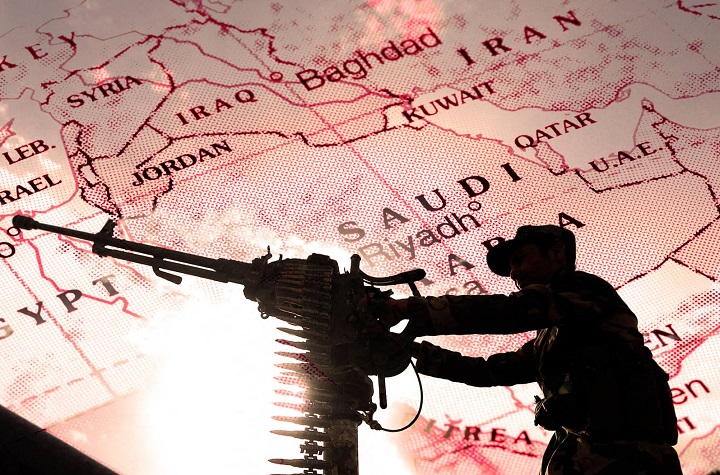The informal head of the very informal alliance that constitutes the Axis of Resistance, politely declined any form of intervention to aid Hamas in the current conflict in Gaza. During an impromptu meeting with the leadership of Hamas in Tehran, Iran’s supreme leader admonished Hamas, remonstrating that you gave us no warning and hence cannot expect an intervention from us.
The comments of the Supreme leader were echoed by Mohammad Javad Zarif the former foreign minister of Iran who warned against an Iranian intervention. He accused the US Secretary of State Antony Blinken of wanting to drag Iran into the Gaza battlefield whilst having no proof of Iran’s complicity in the October 7th attack. He further stressed the impact that a war between Iran and the West would have upon an already crippled Iran and the suffering that would be endured by ordinary Iranians.
The response of the leaders of the Axis of Resistance was to be expected with two US carrier groups parked in the Eastern Mediterranean and a plethora of US bases scattered across the Middle East. The US and its allies are significantly stronger than the usual foes of the axis, namely poorly armed Syrian rebels lacking even the most rudimentary air defence capabilities.
The term Axis of Resistance was originally coined by Al-Zahf Al-Akhdar, a Libyan daily newspaper in response to George W Bush’s comments about an axis of evil and later adopted by Iran’s Leadership. The Axis of Resistance comprises a motley crew of state and non-state actors with often contradictory ideologies, united only in a supposed and shared opposition to the US in particular and the West in general. With the al-Assad regime constituting a liability rather than an asset, there is little more than Iran and its proxy militia that form the Axis.
Although initially seen as the vanguard of resistance to the US in the Middle East its involvement in the Syrian civil war exposed the Axis as nothing more than a rabidly sectarian appendage of the Iranian regime, established solely to further the interest of the Iranian clerics seeking to create a Shia crescent from Iran to the Mediterranean.
Although professing an unstinting resistance to Western interference in the Middle East and beyond, more often than otherwise, it shares common interest with the West in general but the US in particular.
To date its greatest achievement has actually been the preservation of Bashar al Assad’s regime in Damascus, initially spearheaded by Hezbollah, and then buttressed by tens of thousands of Shia Hazara fighters, recruited mainly from Afghanistan. Iran’s involvement in Syria financed tacitly by the release of frozen funds by Obama’s nuclear deal, achieved what Western nations were unwilling to publicly endorse, namely the preservation of al-Assad’s regime was critical to the security of the zionist entity and Western interest in the Middle East.
Hence lies the paradox at the heart of the Axis of Resistance. With the US in particular rather than resistance it has been a case of tacit cooperation, the Axis of Resistance largely supported the overthrow of Saddam Hussain even going as far as allowing the US use of its airspace to conduct airstrikes. When the largely Sunni insurgency ignited after the capture and subsequent execution of Saddam Hussein, it was the Shia militias from the Axis of Resistance that quelled the insurgency and saved the US occupation from bleeding to death which at one point was confined to Baghdad’s Green Zone and a few fortified bases. The US was only able to form a semblance of a government in Iraq with the help of Iran and the control exerted over its proxies in Iraq.
The reality of the Axis of Resistance is there is neither an axis nor any resistance, it consists of little more than Iran and its proxy militias in Iraq, Lebanon and Syria, and despite proclamations and empty rhetoric it is remarkably ineffective against capable adversaries. In Syria its role was confined to providing expendable forces colloquially referred to as “cannon fodder” to occupy land decimated by Russian bombardment, and in Iraq the same was provided for the US in its campaign against ISIS. The US did the bombing and the Axis of Resistance, the dying.
When politics dictate both the US and its client the zionist entity assassinate its leadership at will, with negligible consequences, let alone the constant raids conducted on IRGC centres in Syria by the zionist entity, even the assassination of Qassim Solomani, head of the al-Quds Brigade garnered little more than condemnation and a few misplaced rockets in retaliation.
The weakness of the Axis of Resistance, already hobbled by its sectarian nature, is compounded by the failure of Iran to reign in the political and economic excesses of its proxies and in fact its own clerics. In Iran itself support for the clerical regime is at an all-time low, large proportions of its populace not only despise the regime but also Shi’ism from which it derives its legitimacy. In Iraq, Iran’s proxies forgo any ideas of resistance and engage in grand larceny of the state and its institutions, the militia now constitute little more than sectarian mafia’s horse-trading ministries for political and subsequently economic gain.
Hezbollah in Lebanon fairs no better. The 2020 Beirut Port explosion in which 218 people died and where 7800 were injured due to the ignition of illegally stored ammonium nitrate is blamed squarely on Hezbollah and its involvement in the corruption that forms the Lebanese governance has sapped the credibility of Hezbollah and diminished its popularity even with the Shia whose interest it purports to champion.
The Axis of Resistance has neither the military might nor the political will to engage in conflict with the Jewish entity let alone the US, with little in terms of an axis and even less resistance its impotence in the face of zionist entities aggression is manifest.
Adnan Khan

